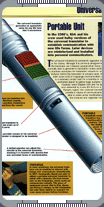
Universal Translator
This commonplace device is able to produce an instant translation of almost any language.
 The universal translator is one of the most significant and valueable devices in use during the 23rd and
24th centuries. It provides an effectively instantaneous translation to and from any number of languages,
including ones that have never been encountered before. Under normal circumstances it is so effective
and discreet that most individuals take it for granted and barely acknowledge its existance.
The universal translator is one of the most significant and valueable devices in use during the 23rd and
24th centuries. It provides an effectively instantaneous translation to and from any number of languages,
including ones that have never been encountered before. Under normal circumstances it is so effective
and discreet that most individuals take it for granted and barely acknowledge its existance.
The translator is built into starship communication systems, and provides translation of all messages to
and from the vessel. In the 2260s, portable versions of the translator - 30 centimeters-long rods - were
sometimes carried on shuttlecraft. Modern devices have been miniaturized to the point where they can
 even be worn inside the ear; these are favored by the Ferengi, who often encounter new species in their
neverending search for trade routes and opportunities. The translator functions by analyzing the
patterns and syntax of a language, and devising a translation matrix that permits instananeous verbal or
data exchanges. The system is already programmed with a massive database of linguistic information
derived from known languages. Thus, when it encounters a variant of a known root language it can analyze
the new language incredibly rapidly and provide an accurate translation.
even be worn inside the ear; these are favored by the Ferengi, who often encounter new species in their
neverending search for trade routes and opportunities. The translator functions by analyzing the
patterns and syntax of a language, and devising a translation matrix that permits instananeous verbal or
data exchanges. The system is already programmed with a massive database of linguistic information
derived from known languages. Thus, when it encounters a variant of a known root language it can analyze
the new language incredibly rapidly and provide an accurate translation.
When the translator encounters an entirely unknown language, it analyzes brain wave frequencies, looks
for universal concepts, and selects similar patterns; it then calculates the grammar and syntax and
electronically generates a spoken translation in real time using an appropriate male or female voice.
The translator requires a relatively large sample of a language before it can provide an accurate
translation. Ideally, the sample should include several examples of two or more native speakers talking
with one another over a significant period of time. Extensive pattern analysis allows the translator to
arrive at a greater understanding of vocabulary, syntax, and cultural factors, and so create a better
match.
|
|
"COMMUNICATIONS" - AUGUST 1999 ISSUE 4 STAR TREK: THE MAGAZINE COPYRIGHT OF PARAMOUNT PICTURES.
|